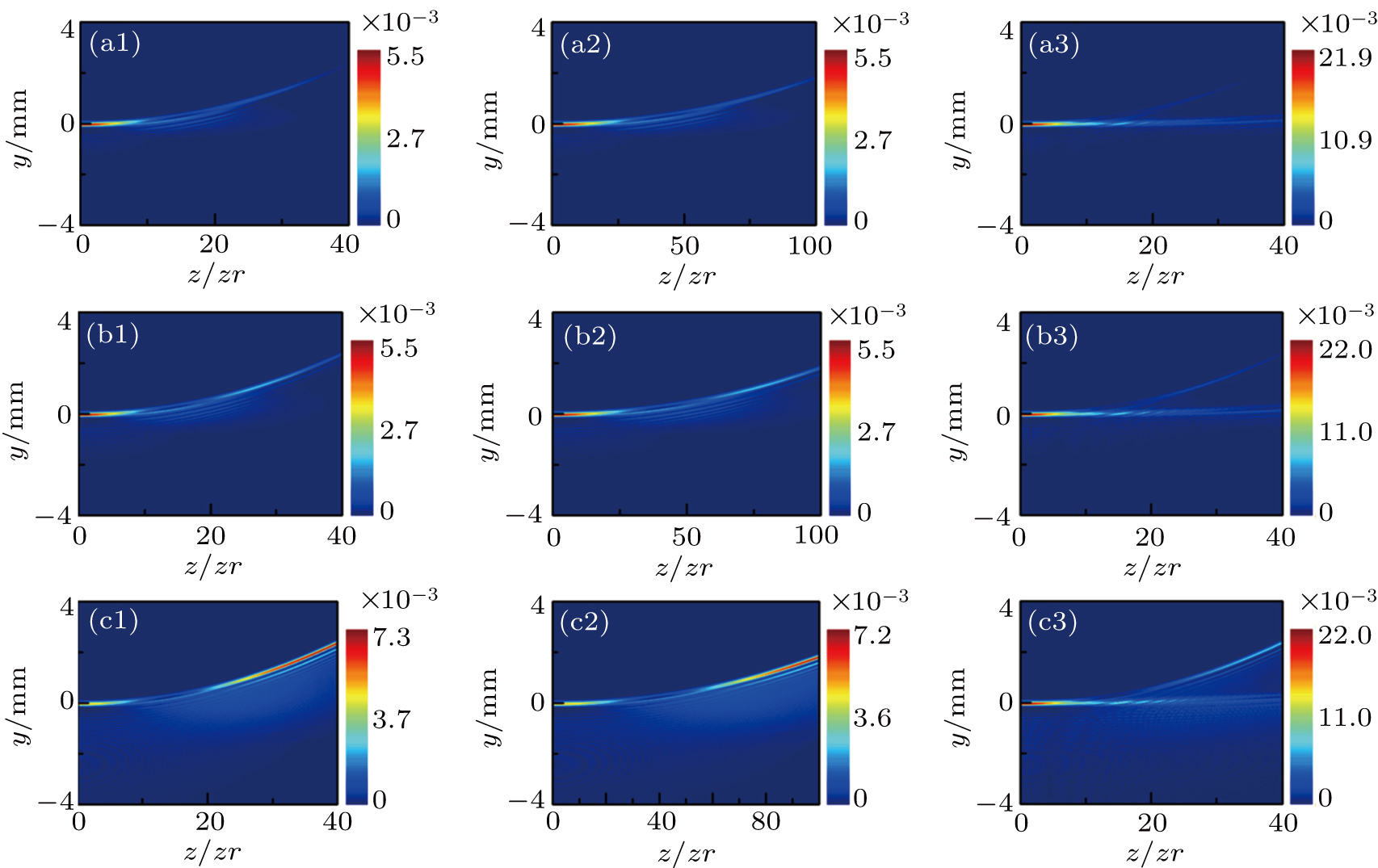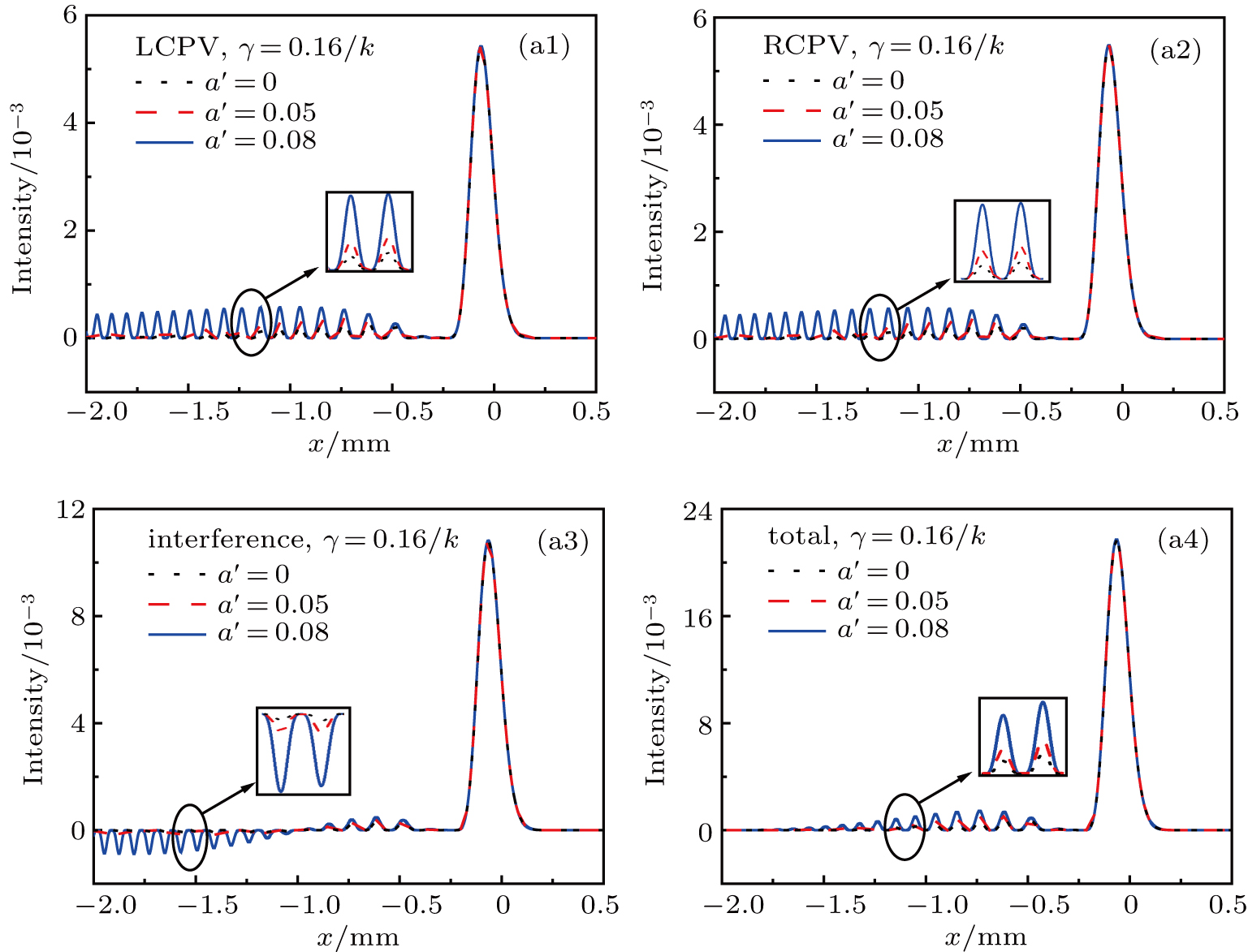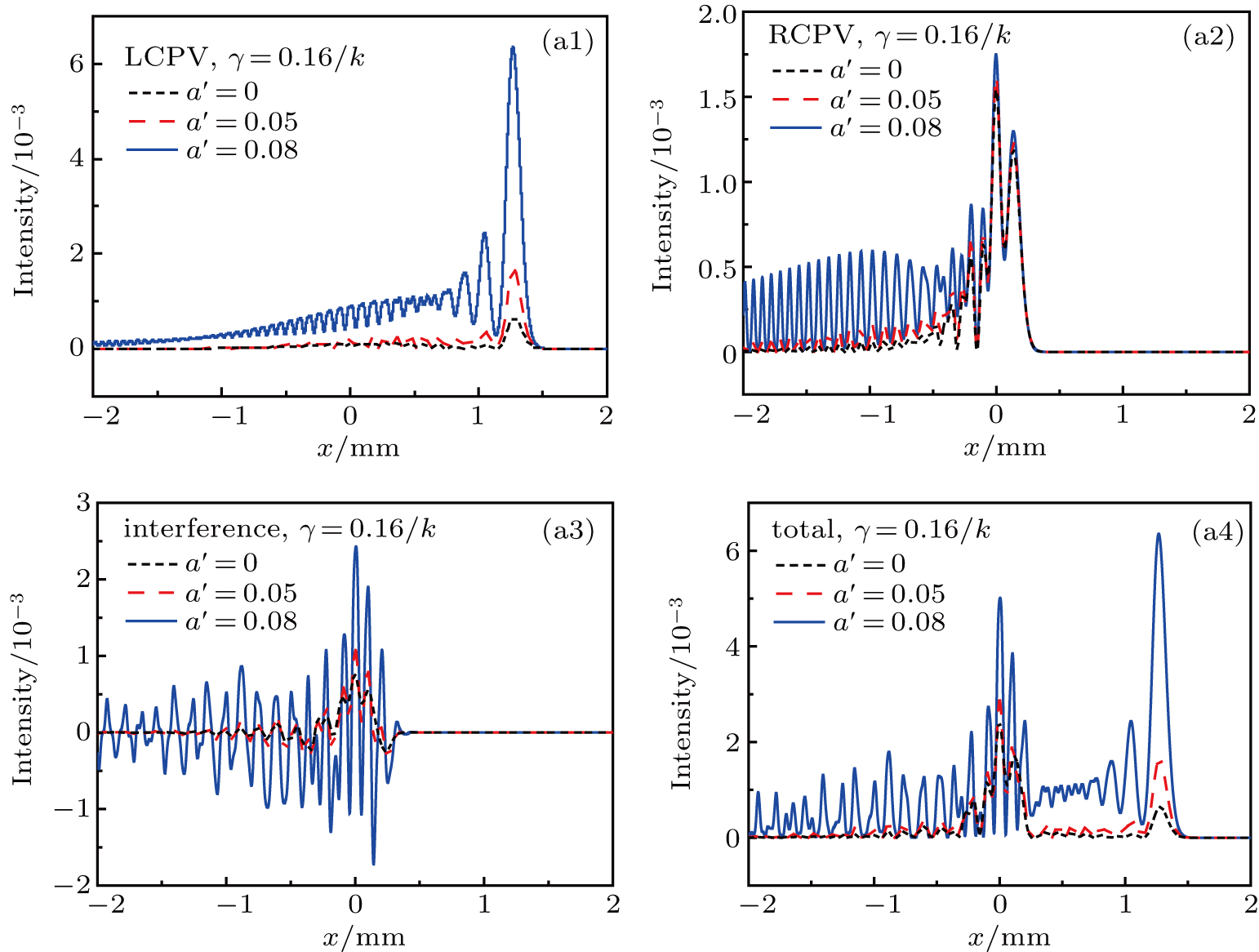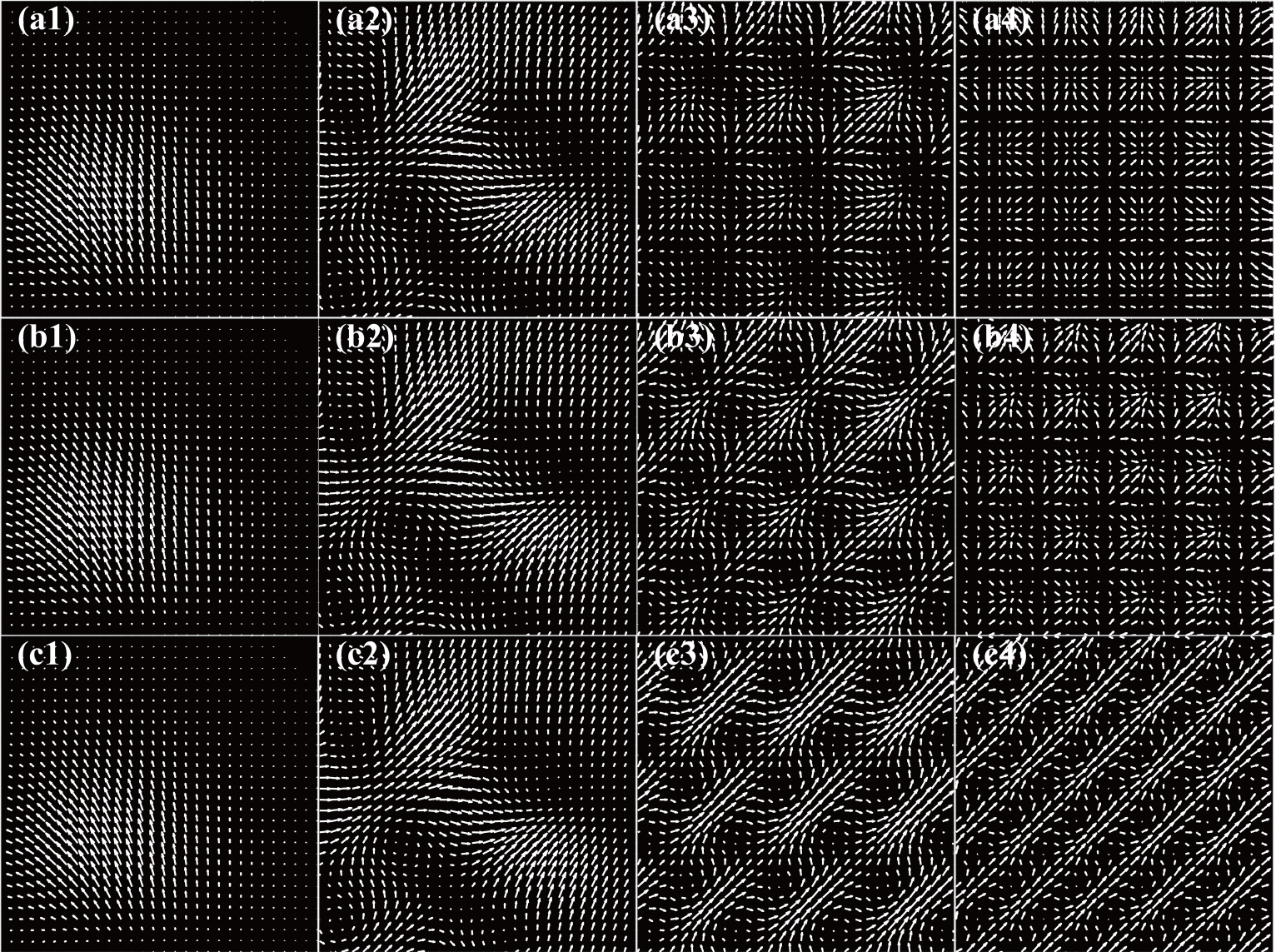† Corresponding author. E-mail:
Project supported by the National Natural Science Foundation of China (Grant Nos. 61601355 and 61571355), the China Postdoctoral Science Foundation (Grant No. 2016M602770), the Natural Science Foundation of Shaanxi Province, China (Grant Nos. 2018JM6018 and 2019JQ-405), the Postdoctoral Science Foundation of Shaanxi Province, China, and the Fundamental Research Funds for the Central Universities, China.
Propagation dynamics of the cosh-Airy vortex (CAiV) beams in a chiral medium is investigated analytically with Huygens–Fresnel diffraction integral formula. The results show that the CAiV beams are split into the left circularly polarized vortex (LCPV) beams and the right circularly polarized vortex (RCPV) beams with different propagation trajectories in the chiral medium. We mainly investigate the effect of the cosh parameter on the propagation process of the CAiV beams. The propagation characteristics, including intensity distribution, propagation trajectory, peak intensity, main lobe’s intensity, Poynting vector, and angular momentum are discussed in detail. We find that the cosh parameter affects the intensity distribution of the CAiV beams but not its propagation trajectory. As the cosh parameter increases, the distribution areas of the LCPV and RCPV beams become wider, and the side lobe’s intensity and peak intensity become larger. Besides, the main lobe’s intensity of the LCPV and RCPV beams increase with the increase of the cosh parameter at a farther propagation distance, which is confirmed by the variation trend of the Poynting vector. It is significant that we can vary the cosh parameter to control the intensity distribution, main lobe’s intensity, and peak intensity of the CAiV beams without changing the propagation trajectory. Our results may provide some support for applications of the CAiV beams in optical micromanipulation.
The Airy packet is a solution of Schrödinger equation for a free particle.[1] Since the Airy beams with finite energy were introduced theoretically and generated experimentally by Siviloglou and Christodoulides in 2007,[2,3] the Airy beams have been extensively studied due to their intriguing properties, including nondiffracting,[4] self-healing,[5] and self-accelerating[2,3] properties. To date, applications of the Airy beams have been explored in optical trapping,[6] curved plasma channel generation,[7,8] and light bullet generation.[9,10] The optical vortex also has some interesting characteristics, such as phase singularity, autofocusing properties, and vector structure,[11] which have been used in optical communication[12] and optical micromanipulation.[13] Recently, the propagation dynamics of an optical vortex superimposed on Airy beams has become a research hotspot. Mazilu et al. have introduced the accelerating vortices embedded in Airy beams by employing a spiral phase on a cubic phase pattern.[14] Dai et al. theoretically and experimentally studied the propagation dynamics of Airy beams carrying phase singularity.[15,16] Subsequently, the propagations of Airy vortex beams in uniaxial crystals,[17–20] chiral medium,[21] gradient-index media,[22] turbulence atmosphere,[23] and nonlocal nonlinear medium[24] have been studied.
The chiral medium has broad applications in the non-linear optics field due to its structure and optical properties.[25] In nature, many materials can be considered as chiral media, such as human tissue, medicinal materials, and certain types of terrestrial vegetation layers.[26] Moreover, owing to the optical activity, when a linearly polarized vortex beam is incident on a chiral medium, it will be split into an LCPV beam and an RCPV beam, which have different phase velocities and propagation trajectories in a chiral medium.[27] Recently, the propagations of various beams in a chiral medium have been investigated, such as vortex Airy beam,[21] first-order chirped Airy vortex beam,[28] Bessel–Gaussian beam,[29] Airy–Gaussian vortex beam,[30] cos-Airy–Gaussian beam,[31] and chirped Airy–Gaussian vortex beam.[32] In this paper, we study the paraxial propagation of the CAiV beams in a chiral medium.
The CAiV beams can be deemed as a superposition of two Airy vortex beams with different decay factors and can be generated by using spatial light modulation.[33–35] Though the propagation properties of cosh-Airy beams are similar to those of the Airy beams, they possess more manipulation degrees of freedom than the corresponding Airy beams.[36] The self-healing property of cosh-Airy beam partially blocked by a finite opaque obstacle is better than that of the corresponding Airy beam.[37] In a word, the properties of the cosh-Airy beam are richer than those of the corresponding Airy beam. The beam propagation factor of a cosh-Airy beam was studied to evaluate the quality of the beam.[38] The periodic phase transition of the cosh-Airy beam was shown in a quadratic-index inhomogeneous medium.[39] The propagation of cosh-Airy beams in free space and uniaxial crystal orthogonal to the optical axis has been investigated.[36,40] But there has been no report on the propagation of the CAiV beams in a chiral medium so far. The investigation in the propagation of CAiV beams in a chiral medium is conducive to understanding the interaction mechanism of CAiV beams with a chiral medium. In the rest of the present paper, we mainly investigate the influence of the cosh parameter on the paraxial propagation of the CAiV beams in a chiral medium.
The rest of this paper is organized as follows. In Section
In the Cartesian coordinate system, the z axis is assumed to be the propagation axis. At the initial plane, the electric field amplitude of an incident CAiV beam in the coordinate system can be described as follows:[36,39]


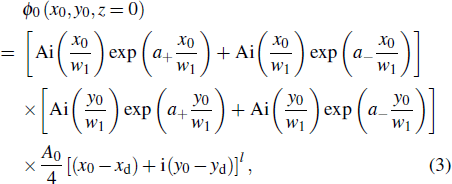
With the Huygens–Fresnel diffraction integral formula, the propagation of the CAiV beams through an optical ABCD system under the paraxial approximation can be determined as follows:[41]







Then, the ABCD transfer matrix of the optical system in the chiral medium can be described as





With the analytical expression of the electric field, we further investigate the propagation properties of the CAiV beams through a chiral medium, with parameters chosen to be A0 = 1, a = 0.1, w1 = w2 = 0.1mm, xd = yd = − 0.3 mm, l = 1, λ = 633 nm, and n0 = 3. 
In Fig.
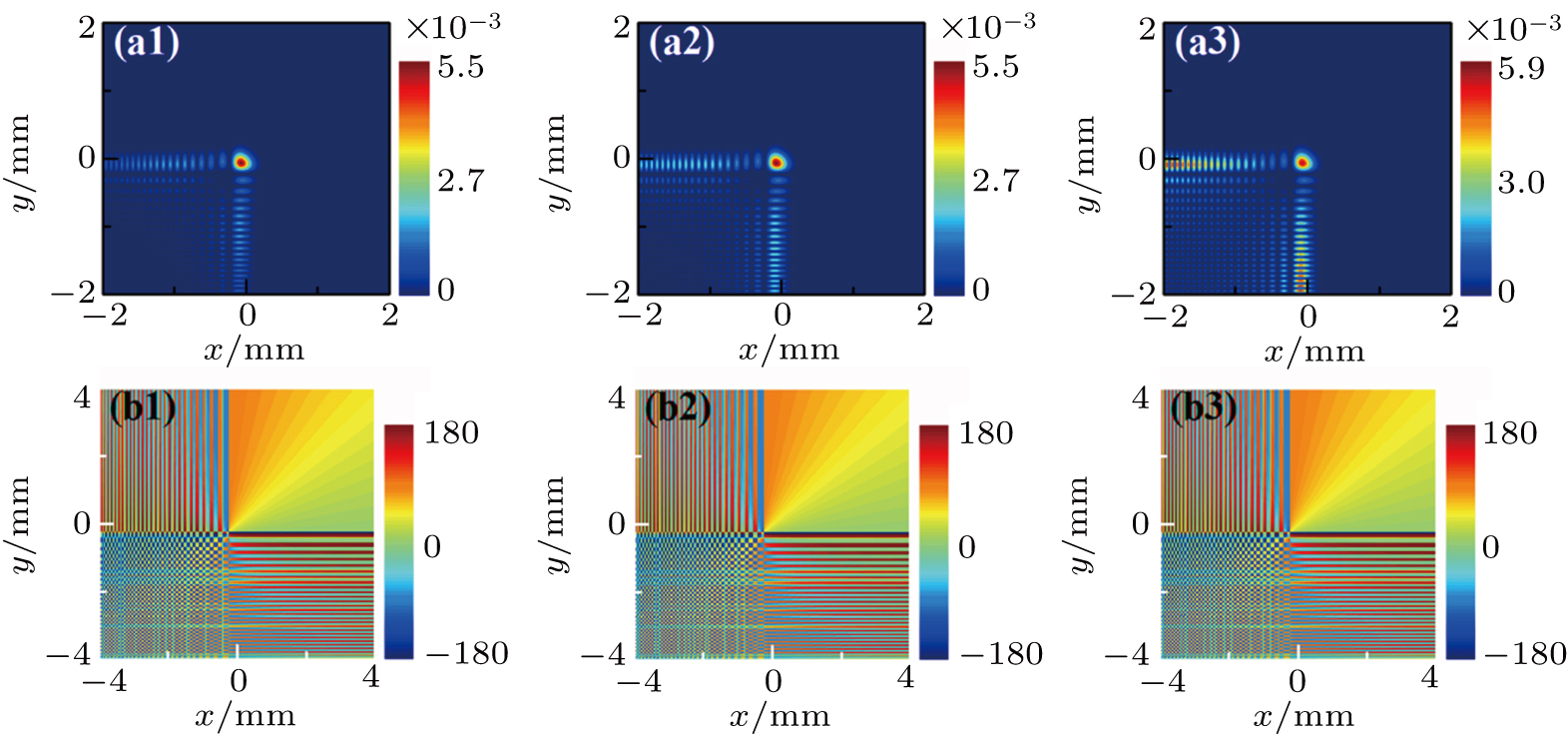 | Fig. 1. (a1)–(a3) Intensity distributions and (b1)–(b3) corresponding phase distributions of the CAiV beams at the initial plane z = 0, a′ = 0, 0.05, and 0.08, respectively. |
Figures
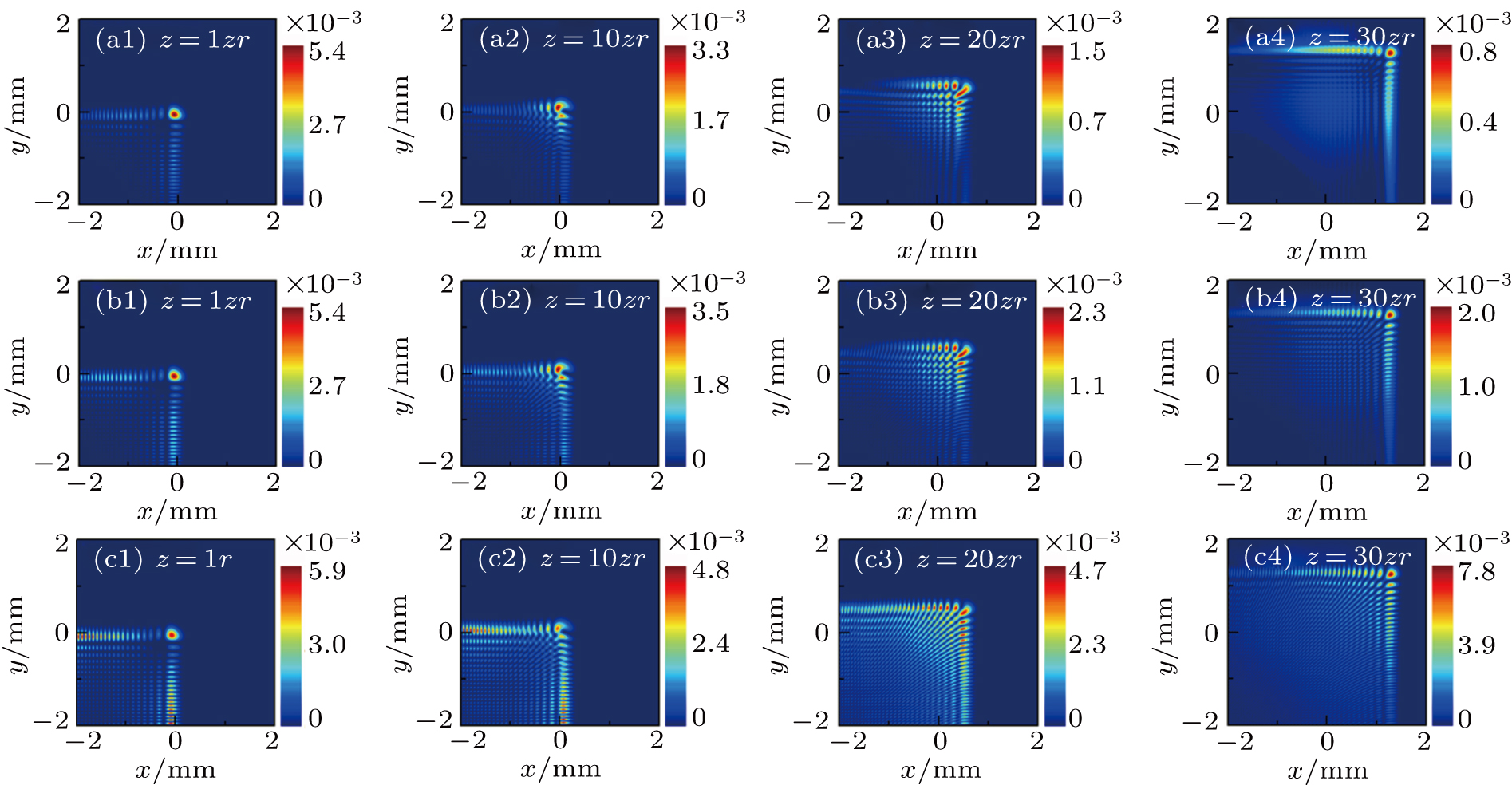 | Fig. 2. Transverse intensity distributions at different propagation distances for LCPV beams with a′ = 0 [(a1)–(a4)], a′ = 0.05 [(b1)–(b4)], a′ = 0.08 [(c1)–(c4)], and γ = 0.16/k. |
 | Fig. 3. Transverse intensity distributions at different propagation distances for the RCPV beams with a′ = 0 [(a1)–(a4)], a′ = 0.05 [(b1)–(b4)], a′ = 0.08 [(c1)–(c4)], and γ = 0.16/k. |
While, at the farther propagation distance (30zr), the increasing side lobes are mainly distributed in the neighborhood of the main lobe. Furthermore, the intensity of the LCPV beams becomes more evenly distributed with the cosh parameters increasing. Similarly, from Fig.
Following Figs.
 | Fig. 4. Transverse intensity distributions at different propagation distances for the total beams with a′ = 0 [(a1)–(a4)], a′ = 0.05 [(b1)–(b4)], a′ = 0.08 [(c1)–(c4)], and γ = 0.16/k. |
The propagation trajectories of the LCPV beams, RCPV beams, and total beams with different cosh parameters are presented in Fig.
In order to further analyze the influence of the cosh parameters on the evolution characteristics of the CAiV beams, in Figs.
Figure
 | Fig. 8. Main lobe’s intensity distributions of (a) LCPV beams and (b) RCPV beams for different cosh parameters propagating in chiral medium. |
The peak intensity distributions of the LCPV beams, RCPV beams, and total beams with different cosh parameters at different propagation distances are presented in Fig.
 | Fig. 9. Peak intensity distributions of (a) LCPV beams, (b) RCPV beams, and (c) total beams for different cosh parameters propagating in chiral medium. |
Finally, we study the Poynting vector and angular momentum of the CAiV beams through the chiral medium with different cosh parameters. The Poynting vector is the rate of electromagnetic energy flow per unit area, which is defined as 


As is well known, 〈


In this paper, the propagation of the CAiV beams in a chiral medium is investigated. We numerically simulate the intensity distribution, propagation trajectory, peak intensity, main lobe’s intensity, Poynting vector, and angular momentum of the CAiV beams with different cosh parameters in a chiral medium. Our results show that the cosh parameters have the same effect on the intensity distribution of the LCPV and RCPV beams. As the cosh parameters increase, the distribution areas of the LCPV and RCPV beams become wider, and the side lobe’s intensity and peak intensity become larger. While, the cosh parameters will not affect the propagation trajectory of the LCPV beams nor RCPV beams. By introducing the cosh parameter, the side lobe’s intensity of the Airy vortex beams increases, which improves the trapping capability of the Airy vortex beams at the side lobes significantly. Moreover, as the cosh parameter increases, the main lobe’s intensity of the LCPV and RCPV beams increase at a farther propagation distance. Therefore, without the propagation trajectory changed, one can adjust the cosh parameters to control intensity distribution, the main lobe’s intensity, and peak intensity of the CAiV beams in the chiral medium to meet the actual usage. Finally, the Poynting vector and angular momentum of the CAiV beams through the chiral medium with different cosh parameters are discussed. We find that higher transverse energy flow moves along the direction of the main Airy peak for the CAiV beams with the increase of cosh parameters. We believe that our investigation is valuable for fully exploring the possibility and functionality of the CAiV beams in optical manipulation.
| [1] | |
| [2] | |
| [3] | |
| [4] | |
| [5] | |
| [6] | |
| [7] | |
| [8] | |
| [9] | |
| [10] | |
| [11] | |
| [12] | |
| [13] | |
| [14] | |
| [15] | |
| [16] | |
| [17] | |
| [18] | |
| [19] | |
| [20] | |
| [21] | |
| [22] | |
| [23] | |
| [24] | |
| [25] | |
| [26] | |
| [27] | |
| [28] | |
| [29] | |
| [30] | |
| [31] | |
| [32] | |
| [33] | |
| [34] | |
| [35] | |
| [36] | |
| [37] | |
| [38] | |
| [39] | |
| [40] | |
| [41] | |
| [42] | |
| [43] | |
| [44] | |
| [45] | |
| [46] |


